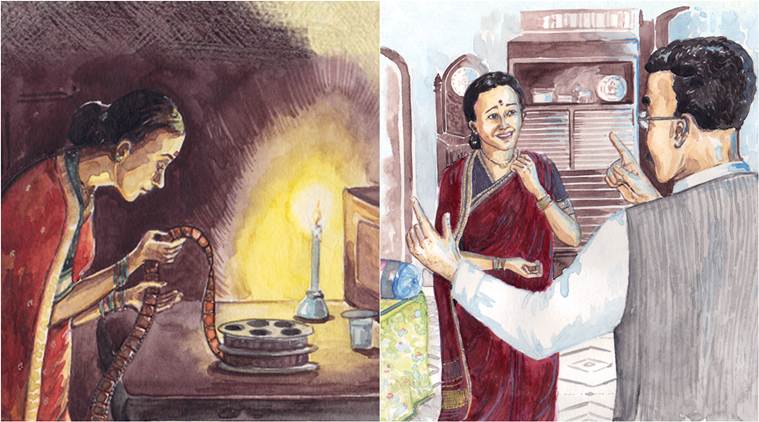This article is a part of the #IndianWomenInHistory campaign for Women’s History Month to remember the untold legacies of women who shaped India, especially India’s various feminist movements. One Indian woman is profiled each day for the whole of March 2019.
Dadasaheb Phalke, the maker of India’s first full-length feature film Raja Harishchandra, is a commonly known name. Every year, a prestigious award is given his name to members of outstanding achievement in the film fraternity. Even so, there have been lapses in the true recognition of his contribution to Indian cinema. His family members have made demands such as the preservation of the house where he lived and made films, inviting his descendants for awards functions, and bestowment of a posthumous Bharat Ratna. Among these demands is another one: that of providing recognition to Saraswatibai Phalke, Dadasaheb’s wife, without whom his films would not have been a reality.

From the book ‘Lights…Camera…Action! The Life and Times of Dadasaheb Phalke ‘ by Rupali Bhave. Image Source: Indian Express
Her story as a film editor and technician is much like the unsung behind-the-scenes crew, without whom a film cannot possibly be made. Chandrashekhar Pusalkar, her grandson, once said in an interview “…the best way to recognise Dadasaheb’s contribution to Indian cinema with a Bharat Ratna. We would like a similar honour for my grandmother, Saraswatibai Phalke. We would be happy if Saraswatibai’s contribution is recognised in some way. At least, an award in her name should be given to the best female director or producer.”
Believed to be India’s first film editor and technician, she worked tirelessly on the sets of her husband’s films. She picked up the existing technology, mixed film-developing chemicals, and perforated raw film sheets.
Saraswatibai Phalke (born as Kaveribai Karandikar) was married to Dadasaheb Phalke in 1902 as a 14-year-old. Widower Dadasaheb, who was initially opposed to marrying a girl almost 19 years younger than him, eventually gave in to pressure by his family.
Before being enamoured by the world of cinema, Dadasaheb held multiple jobs, and eventually started his own printing press. Even as a teenager, Saraswatibai worked alongside her husband and helped him run and manage this business.
As he grew into a filmmaker, she not only provided him support but also actively participated in film-making. Dadasaheb’s friends and family scoffed at his dreams to create films, but his wife stood by him and showed faith in his mission. Believed to be India’s first film editor, she worked tirelessly on the sets of her husband’s films. She picked up the existing technology, mixed film-developing chemicals, and perforated raw film sheets. She tirelessly held white bedsheets as light reflectors, even in the hot afternoon sun.

Dadasaheb Phalke once took Saraswatibai to watch an American film in Mumbai, called ‘The Life of Christ’. He told a fascinated Saraswatibai that he too, would make a film. She not only provided strong emotional support to his dream, but also sold her jewellery so that he could go to London to learn the art of film-making from Cecil Hepworth, and buy equipment from Germany.
Also read: Saraswati Devi: One Of The First Music Directors In Indian Cinema | #IndianWomenInHistory
Apart from Saraswatibai’s immense contribution to the film sets, she also prepared meals for the crew of 60-70 people. As a woman, she also fulfilled her traditional gender role of nurturing her children. However, Saraswatibai was not merely involved in the production aspect. She had many brainstorming sessions with her husband, as she also contributed to the creative aspects of film-making.
As a woman, her efforts have been overshadowed by her husband’s achievements, which ironically would not have happened without her.
Dadasaheb wanted to cast her as the female lead in Raja Harishchandra. But she stayed firm in her refusal, and said, “I am already involved in so many things! If I act too, who will do all the things I am doing now?” This role was eventually played by a male actor.
Even though she never gained the popularity that her husband did, Saraswatibai’s role has been recognised by many accounts and narratives from the era. In a children’s book released in 2016, called Lights…Camera…Action! The Life and Times of Dadasaheb Phalke, Saraswatibai’s position as a creative collaborator receives its due attention. “In all the material I read, the information available about Saraswatibai gave me a feeling that she provided the support system that enabled Dadasaheb to achieve his vision. Not only did she support his work but also actively participated in it,” says Rupali Bhave, the writer.
Also read: Supriya Devi: The Gem Of Bengali Cinema | #IndianWomenInHistoryH
Her contribution to the art and craft of filmmaking in India is immeasurable. After his death, it is said that she also wrote an autobiography on her journey, which was unfortunately lost. Like many ambitious and visionary women, she worked on her career whilst also being a homemaker and caregiver to her family. As a woman, her efforts have been overshadowed by her husband’s achievements, which ironically would not have happened without her.
References
1. Telegraph India
2. Live History India
3. Indian Express
About the author(s)
Tanika Godbole is a writer/journalist based in Mumbai. She is interested in LGBT and women's rights, and is keen on writing about those topics. She also makes terribly drawn comics on human rights and pop culture. They can be found on https://www.facebook.com/godbolet/




